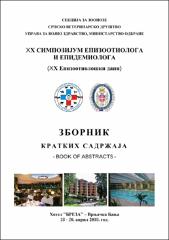| dc.contributor.author | Petrović, Jelena | |
| dc.contributor.author | Grgić, Živoslav | |
| dc.contributor.author | Prodanov-Radulović, Jasna | |
| dc.contributor.author | Pušić, Ivan | |
| dc.contributor.author | Ratajac, Radomir | |
| dc.contributor.author | Mirčeta, Jovan | |
| dc.contributor.author | Medić, Snežana | |
| dc.date.accessioned | 2019-11-03T15:49:59Z | |
| dc.date.available | 2019-11-03T15:49:59Z | |
| dc.date.issued | 2018 | |
| dc.identifier.isbn | 978-86-83115-33-4 | |
| dc.identifier.uri | https://repo.niv.ns.ac.rs/xmlui/handle/123456789/113 | |
| dc.description.abstract | Trichinellosis is one of the most important food borne parasitic diseases in Serbia. Sporadic cases and outbreaks are recorded every year. Trichinellosis has high significance for human health because it is continuously recorded in whole country, with high incidence and hospitality rate and occasional lethal outcomes. Therefore the main goal of this paper is consideration of the most important causes of emergence of trichinellosis in observed region. The research included a retrospective analysis of data on registered human cases and sources of infection in the South Bačka and Srem district in the period from 2007 to 2016. In the observed period, 39 outbreaks with a total of 467 ill persons (incidence from 0.47 to 4.87/ 100 000 inhabitants) were registered. In eight outbreaks, Trichinella spiralis was detected by the PCR method as causative agent. There are no recorded outbreaks caused by the consumption of meat derived from commercial pig production. Traditional meat products were the most frequently incriminated food source (81.2% outbreaks with 90.7% diseased people), then raw sausages (12.5%/3.8%) and meat derived from backyard pigs (6.2%/ 5.5%). The causes of epidemics were: dominantly consumption of unexamined meat from backyard pigs (50.5%/62.5%), consumption of illegally produced meat products (44.5%/25.0%) and errors during examination (4.9%/12.5%). The most frequent errors during examinations were: examination by an unauthorized person, meat was not examined, insufficient quantity of the meat, examination meat parts other than diaphragm by compression method and examination of the samples by compression method for which it is prescribed by law to be examined by an artificial digestion method.
From the obtained results it can be concluded that in order to reduce the number of human trichinellosis cases in our country, it is necessary to intensify the education of inhabitants in the following period, take more strict measures to prevent illegal production and trade of traditional meat products, and also start with control and certification of authorized veterinary stations/ ambulances that examine meat. | en_US |
| dc.description.sponsorship | The study was funded by Serbian Ministry of Education, Science and Technological Development projects TR 31084 | en_US |
| dc.language.iso | other | en_US |
| dc.publisher | Srpsko veterinarsko društvo, Sekcija za zoonoze | en_US |
| dc.source | Zbornik kratkih sadržaja, Abstrakts Book, XX Simpozijum epizootiologa i epidemiologa (XX Epizootiološki dani), Vrnjačka Banja, 18-20. april 2018 | sr |
| dc.subject | Trichinella spiralis | en_US |
| dc.subject | epidemiologija | en_US |
| dc.subject | trihineloza | en_US |
| dc.subject | ilegalni promet | en_US |
| dc.title | Epidemiologija trihineloze: uzroci nastanka na teritoriji Južnobačkog i Sremskog okruga | en_US |
| dc.title.alternative | Epidemiology of trichinellosis: causes of emergence on the teritory of South Bačka and Srem district | en_US |
| dc.title.alternative | | en_US |
| dc.type | Book chapter | en_US |

